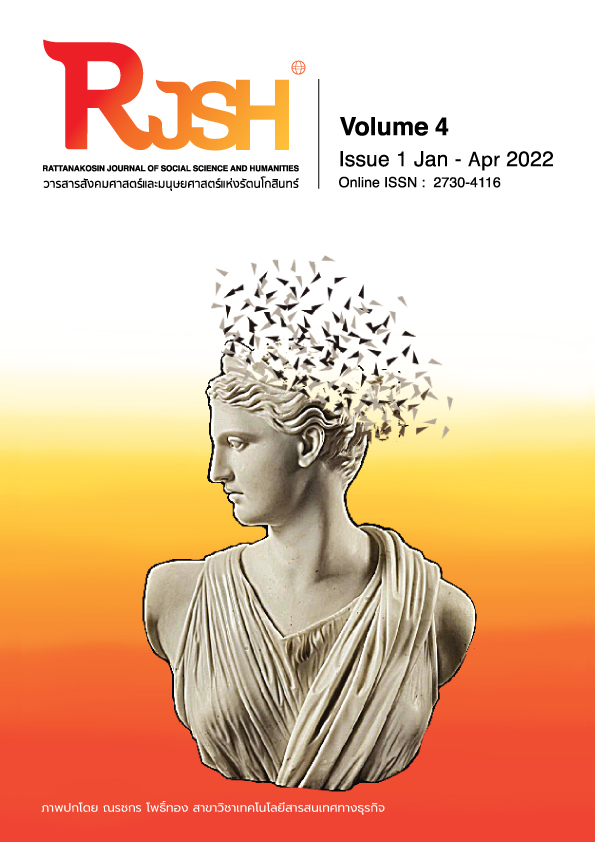Folklore, Culture, Ways of Life: Case Study of OTOP Innovations Tourism Community Potential in 21 Communities, Nakhon Pathom Province
Main Article Content
Abstract
This research aimed to investigate: 1) the general context of 21 OTOP inno-life tourism-based communities, 2) local wisdom, culture, lifestyles of 21 communities, and 3) potential for tourism of the 21 communities to strengthen its foundation to support the OTOP products which are unique, wealthy, and stable in terms of general context, wisdom, culture, life, and tourism potential. The qualitative research was designed to gather data through in-depth interviews with 63 interviewing participants and participant observation was conducted. Data were analyzed using content analysis. The results demonstrated as follows: 1) The general context of OTOP Inno-Life tourism-based communities can be divided into three groups: (1) ethnic and wisdom, (2) sufficiency economy, and (3) agricultural enterprises. 2) Wisdom, culture, and lifestyles of such 21 communities differed as follows: (1) For the ethnic and local wisdom group, all of the products are handicrafts, hand-woven silks, potteries, bamboo, and water hyacinth baskets, herbs, and agricultural products processing. (2) Group of sufficiency economy brings in local wisdom, culture, and lifestyles to promote local agriculture as sufficiency economy model, organic agriculture, agricultural product, and food processing. (3) For the group of agricultural enterprises, they spend life simply along with the canal. They are well known as agro-tourism management cruise, traveling by trams to see nature and garden as well as and studying how to process local fruits. 3) The potential for 21 OTOP Inno-Life tourism-based communities was to develop the strength of its foundation to support OTOP products with uniqueness, wealth, stabilities by using five development processes: (1) staff (2) tourist attraction and facilities (3) products and services (4) connection of routes in each area, and (5) local tourism markets. This could be a guideline for driving and supporting the potential for the OTOP community much more wealthy and stable.
Article Details
The content within the published articles, including images and tables, is copyrighted by Rajamangala University of Technology Rattanakosin. Any use of the article's content, text, ideas, images, or tables for commercial purposes in various formats requires permission from the journal's editorial board.
Rajamangala University of Technology Rattanakosin permits the use and dissemination of article files under the condition that proper attribution to the journal is provided and the content is not used for commercial purposes.
The opinions and views expressed in the articles are solely those of the respective authors and are not associated with Rajamangala University of Technology Rattanakosin or other faculty members in the university. The authors bear full responsibility for the content of their articles, including any errors, and are responsible for the content and editorial review. The editorial board is not responsible for the content or views expressed in the articles.
References
กรมการพัฒนาชุมชน กระทรวงมหาดไทย. (2561). คู่มือบริหารโครงการชุมชนท่องเที่ยว OTOP นวัตวิถี กรุงเทพฯ: กรมการพัฒนาชุมชน.
กรมพัฒนาชุมชน. (2563). OTOP นวัตวิถี. สืบค้นเมื่อ 4 พฤษภาคม 2563 จาก www.Thairath.co.th.
กรมส่งเสริม กระทรวงวัฒนธรรม. (2559). กรุงเทพฯ : รุ่งศิลป์การพิมพ์ (1977).
การท่องเที่ยวแห่งประเทศไทย. (2563). สืบค้นเมื่อ 14 สิงหาคม 2563 จาก http://www.oic.go.th/FILEWEB/CABINFOCENTER2/DRAWER073/GENERAL/DATA0000/00000064
การสร้างงาน สร้างรายได้ สร้างอาชีพ. (2563). สืบค้นเมื่อ 8 พฤษภาคม 2563 จาก http://nwnt.prd.go.th.
จิตติมา พลศักดิ์. (2562). แนวทางการบริหารจัดการชุมชนสู่กระบวนการขับเคลื่อนชุมชนท่องเที่ยว OTOP. รายงานวิจัยมหาวิทยาลัยราชภัฏศรีสะเกษ.
ปทุมพร แก้วคำ และคณะ. (2561). การจัดการท่องเที่ยวโดยชุมชนบ้านฮ่องแฮ่. วารสารวิทยาลัยดุสิตธานี. 12(3), 133 – 149.
ประเวศ วะสี. (2533). การสร้างสรรค์ภูมิปัญญาไทยเพื่อการพัฒนา. เอกสารสัมมนาทางวิชาการ.มหาสารคามเกี่ยวกับการประกอบการพาณิชย์อิเล็กทรอนิกส์. สถาบันวิจัยและพัฒนามหาวิทยาลัยราชภัฏมหาสารคาม.
พัชโรดม อุนสุวรรณ. (2561). การเตรียมนักท่องเที่ยวของชุมชน. สืบค้นเมื่อ 25 มิถุนายน 2563 จาก https://plan.cdd.go.th/wp-content/uploads/sites/97/2018/06/140661B2.pdf
ยุทธศาสตร์ชาติ 20 ปี (พ.ศ. 2560 – 2579). (2561). สืบค้นเมื่อ 4 พฤษภาคม 2563 จาก https://www.matichonweekly.com.
วีรศักดิ์ พิชัยรัตนพงศ์และคณะ. (2547). ปัจจัยที่ส่งผลต่อความสำเร็จของผลิตภัณฑ์ OTOP : ศึกษากรณีผลิตภัณฑ์ 5 ดาวระดับภาค จังหวัดราชบุรี. เอกสารสัมมนาเชิงปฏิบัติการ.
สุเทพ ซิงลอ. ประวัติลาวโซ่งบ้านดอนทราย. นักเล่าเรื่องชุมชน. สัมภาษณ์ 4 กรกฎาคม 2563.


